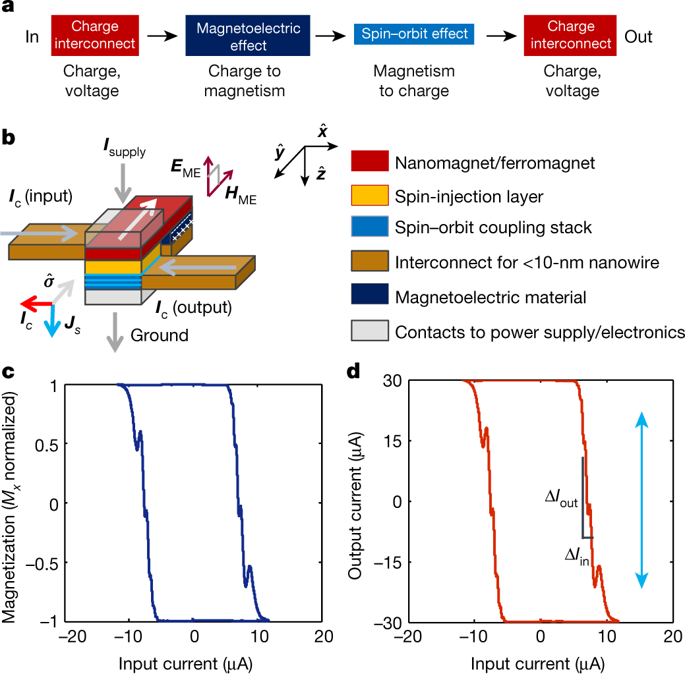Our official English website, www.x-mol.net, welcomes your feedback! (Note: you will need to create a separate account there.)
Scalable energy-efficient magnetoelectric spin–orbit logic
Nature ( IF 64.8 ) Pub Date : 2018-12-03 , DOI: 10.1038/s41586-018-0770-2 Sasikanth Manipatruni , Dmitri E. Nikonov , Chia-Ching Lin , Tanay A. Gosavi , Huichu Liu , Bhagwati Prasad , Yen-Lin Huang , Everton Bonturim , Ramamoorthy Ramesh , Ian A. Young
Nature ( IF 64.8 ) Pub Date : 2018-12-03 , DOI: 10.1038/s41586-018-0770-2 Sasikanth Manipatruni , Dmitri E. Nikonov , Chia-Ching Lin , Tanay A. Gosavi , Huichu Liu , Bhagwati Prasad , Yen-Lin Huang , Everton Bonturim , Ramamoorthy Ramesh , Ian A. Young

|
Since the early 1980s, most electronics have relied on the use of complementary metal–oxide–semiconductor (CMOS) transistors. However, the principles of CMOS operation, involving a switchable semiconductor conductance controlled by an insulating gate, have remained largely unchanged, even as transistors are miniaturized to sizes of 10 nanometres. We investigated what dimensionally scalable logic technology beyond CMOS could provide improvements in efficiency and performance for von Neumann architectures and enable growth in emerging computing such as artifical intelligence. Such a computing technology needs to allow progressive miniaturization, reduce switching energy, improve device interconnection and provide a complete logic and memory family. Here we propose a scalable spintronic logic device that operates via spin–orbit transduction (the coupling of an electron’s angular momentum with its linear momentum) combined with magnetoelectric switching. The device uses advanced quantum materials, especially correlated oxides and topological states of matter, for collective switching and detection. We describe progress in magnetoelectric switching and spin–orbit detection of state, and show that in comparison with CMOS technology our device has superior switching energy (by a factor of 10 to 30), lower switching voltage (by a factor of 5) and enhanced logic density (by a factor of 5). In addition, its non-volatility enables ultralow standby power, which is critical to modern computing. The properties of our device indicate that the proposed technology could enable the development of multi-generational computing.A scalable spintronic device operating via spin–orbit transduction and magnetoelectric switching and using advanced quantum materials shows non-volatility and improved performance and energy efficiency compared with CMOS devices.
中文翻译:

可扩展的节能磁电自旋轨道逻辑
自 1980 年代初以来,大多数电子产品都依赖于互补金属氧化物半导体 (CMOS) 晶体管的使用。然而,涉及由绝缘栅极控制的可切换半导体电导的 CMOS 操作原理在很大程度上保持不变,即使晶体管被小型化到 10 纳米。我们研究了 CMOS 之外的哪些尺寸可扩展逻辑技术可以提高冯诺依曼架构的效率和性能,并促进新兴计算(如人工智能)的增长。这种计算技术需要允许逐步小型化、降低开关能量、改善设备互连并提供完整的逻辑和存储器系列。在这里,我们提出了一种可扩展的自旋电子逻辑器件,它通过自旋轨道转换(电子的角动量与其线性动量的耦合)结合磁电开关进行操作。该设备使用先进的量子材料,尤其是相关的氧化物和物质的拓扑状态,用于集体开关和检测。我们描述了磁电开关和状态自旋轨道检测的进展,并表明与 CMOS 技术相比,我们的器件具有优越的开关能量(10 到 30 倍)、更低的开关电压(5 倍)和增强逻辑密度(乘以 5)。此外,其非易失性可实现超低待机功耗,这对现代计算至关重要。
更新日期:2018-12-03
中文翻译:

可扩展的节能磁电自旋轨道逻辑
自 1980 年代初以来,大多数电子产品都依赖于互补金属氧化物半导体 (CMOS) 晶体管的使用。然而,涉及由绝缘栅极控制的可切换半导体电导的 CMOS 操作原理在很大程度上保持不变,即使晶体管被小型化到 10 纳米。我们研究了 CMOS 之外的哪些尺寸可扩展逻辑技术可以提高冯诺依曼架构的效率和性能,并促进新兴计算(如人工智能)的增长。这种计算技术需要允许逐步小型化、降低开关能量、改善设备互连并提供完整的逻辑和存储器系列。在这里,我们提出了一种可扩展的自旋电子逻辑器件,它通过自旋轨道转换(电子的角动量与其线性动量的耦合)结合磁电开关进行操作。该设备使用先进的量子材料,尤其是相关的氧化物和物质的拓扑状态,用于集体开关和检测。我们描述了磁电开关和状态自旋轨道检测的进展,并表明与 CMOS 技术相比,我们的器件具有优越的开关能量(10 到 30 倍)、更低的开关电压(5 倍)和增强逻辑密度(乘以 5)。此外,其非易失性可实现超低待机功耗,这对现代计算至关重要。



























 京公网安备 11010802027423号
京公网安备 11010802027423号